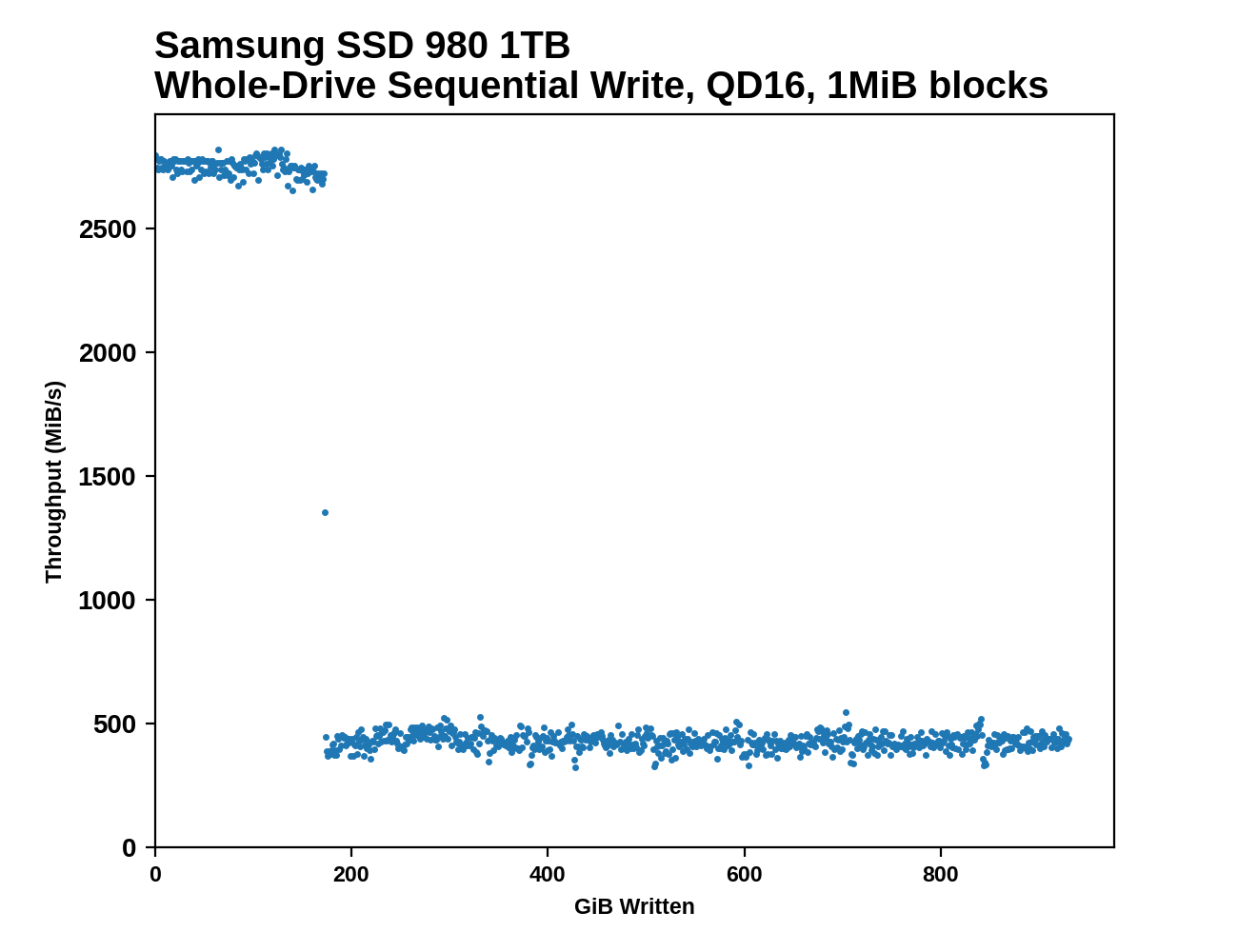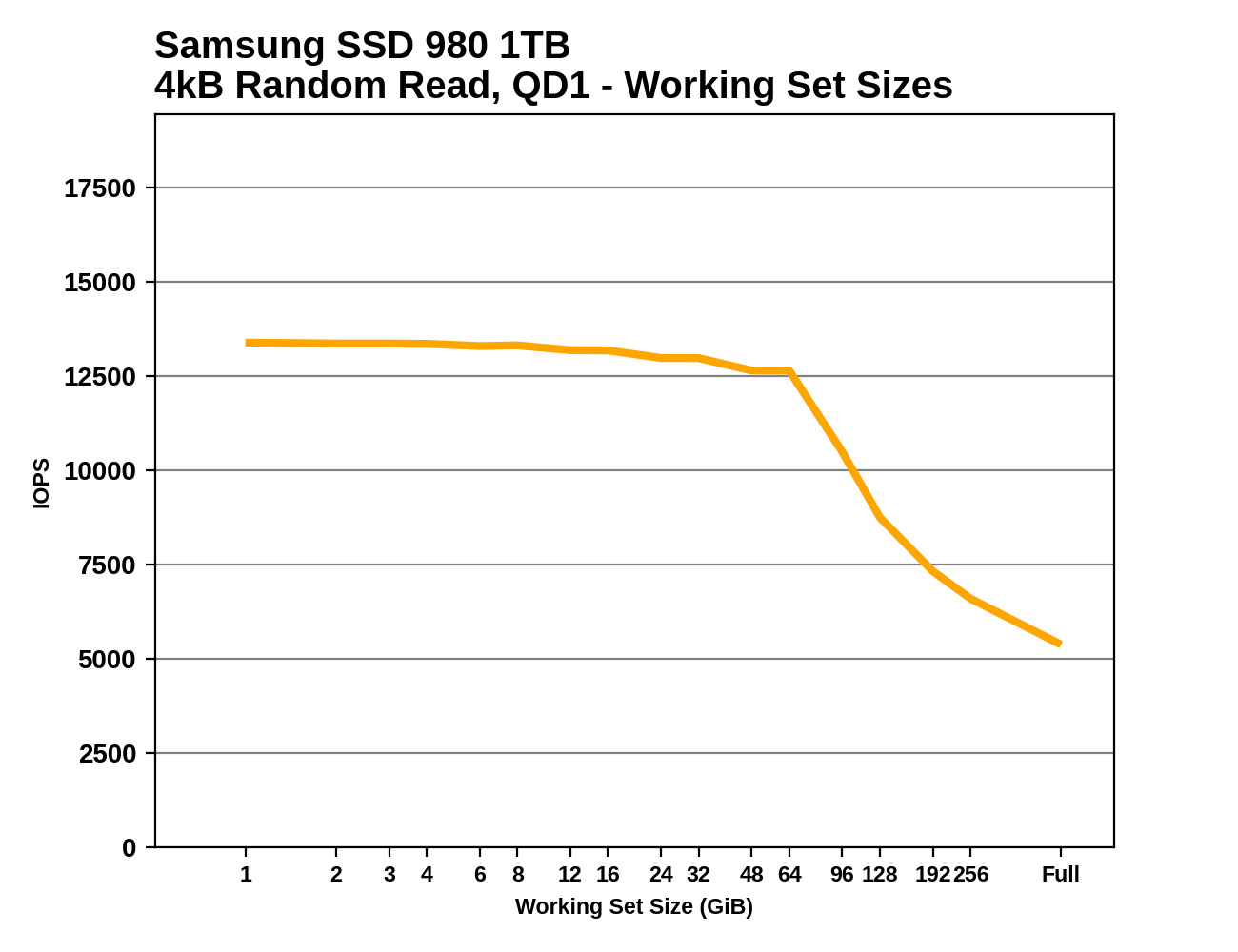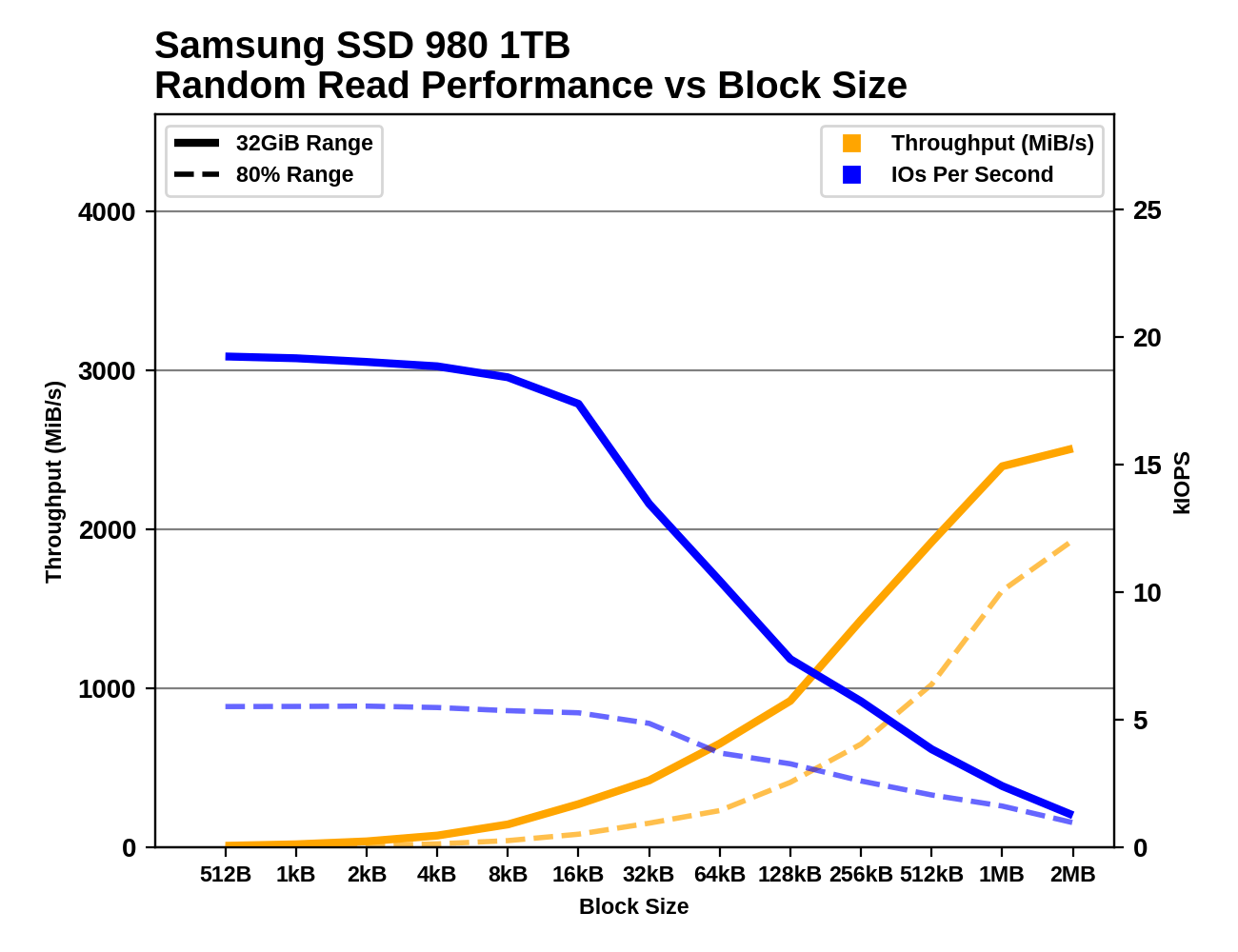The Samsung SSD 980 (500GB & 1TB) Review: Samsung's Entry NVMe
by Billy Tallis on March 9, 2021 10:00 AM ESTAdvanced Synthetic Tests
Our benchmark suite includes a variety of tests that are less about replicating any real-world IO patterns, and more about exposing the inner workings of a drive with narrowly-focused tests. Many of these tests will show exaggerated differences between drives, and for the most part that should not be taken as a sign that one drive will be drastically faster for real-world usage. These tests are about satisfying curiosity, and are not good measures of overall drive performance. For more details, please see the overview of our 2021 Consumer SSD Benchmark Suite.
Whole-Drive Fill
 |
|||||||||
| Pass 1 | |||||||||
| Pass 2 | |||||||||
The Samsung SSD 980 clearly has larger SLC caches than the 970 EVO Plus or 980 PRO, as advertised. But post-cache performance is about a third that of the 970 EVO Plus when comparing the 1TB models, and the 500GB 980 is even slower post-cache. The apparent cache sizes are about 100GB for the 500GB model and 173GB for the 1TB model: a bit larger than advertised for the 1TB and a bit smaller than advertised for the 500 GB. On the second pass of filling the drives, the 1TB 980 never gets back up to full SLC cache speed, and the 500GB model only does for about 5GB. Samsung didn't give specs for the minimum SLC cache size, but it's clear there's not much left when the 980 is full.
 |
|||||||||
| Average Throughput for last 16 GB | Overall Average Throughput | ||||||||
The 1TB SSD 980's performance on the whole-drive fill averages out to just a hair slower than the 1TB 870 EVO, and the 500GB model is about 25% slower than that. It's clear that both the narrower 4-channel controller and the lack of DRAM are both contributing to the lower write throughput of the SSD 980 as compared with Samsung's high-end NVMe drives.
Working Set Size
 |
|||||||||
The 64MB Host Memory Buffer used by the SSD 980 is very clearly illustrated by this test. Without HMB enabled, the 980's random read performance suffers even for small working set sizes of just a few GB, indicating there's very little on-controller RAM. For extremely large working set sizes, the 980's performance drops below the SATA 870 EVO.
The WD Blue SN550 shows slightly worse random read performance than the SSD 980 for smaller working set sizes, and its smaller HMB allocation means performance starts dropping sooner. But at large working set sizes or with HMB off, the SN550 retains more performance, and the SN550 seems to have more on-chip RAM for use when HMB is unavailable.
Performance vs Block Size
 |
|||||||||
| Random Read | |||||||||
| Random Write | |||||||||
| Sequential Read | |||||||||
| Sequential Write | |||||||||
The Samsung SSD 980 maintains high random read IOPS up to block sizes of 16kB, and throughput starts to saturate once the block size is up to about 1MB. For random writes, IOPS starts dropping after 4kB, or after just 2kB when the test is hitting 80% of the drive. With HMB off, the 980 shows a clear preference for 4kB block size for random writes. Sequential reads show odd behavior for block sizes from 32kB to 128kB, with performance stalling then regressing despite increased block size. This happens for both capacities, with or without HMB, so it's a systemic quirk—and an unfortunate one, since 128kB is the usual block size for sequential IO benchmarks. For sequential writes the SSD 980 is well-behaved with smooth scaling of throughput as block sizes increase. Neither capacity of the SSD 980 runs into SLC cache size limits during these tests.
By contrast, the WD Blue SN550 shows much stronger signs of optimization specifically for 4kB block sizes: the effect is small for random reads but huge for random or sequential writes. Sub-4kB accesses are a generally not worth the trouble on the SN550. This drive also appears to occasionally run out of SLC cache during the random write block size testing.










54 Comments
View All Comments
Oxford Guy - Tuesday, March 9, 2021 - link
Intel is really not the best company to compare with. Intel is obsessed with QLC nonsense even more than Samsung is, it seems. And, Intel is rubbing its mitts together about foisting PLC onto the public, as if its new 9000 series FX CPUs aren't enough of a disaster.I have had good results with the Inland TLC drives, both in SATA and in NVME format. However, Gigabyte designed one of the motherboards I have so idiotically that the Performance Plus drive can't be used. The NVME slot is too close to the CPU socket (hits my EK block) and the expansion slot (hits that, too). One would think an ATX board with one NVME slot could be done intelligently, especially with what was once the top chipset.
Due watch with Inland, though, because the product naming is not nearly as clear as it should be. There are "Premium" and "Professional" drives, for instance — as if there is some kind of clarity there.
Slash3 - Tuesday, March 9, 2021 - link
I've replied to one of your previous posts about this NVMe issue, but as it seems to be your favorite campfire story so I'll try digging a bit deeper this time.NVMe M.2 drives fit fine on that motherboard. It's a close fit, but nobody else has had the same difficulties. If the drive doesn't fit, it means it isn't installed correctly or has an oversized heatsink on it. Since the Inland drives don't ship with a heatsink, that means it's not lined up properly in the slot.
That EK uses a weird, oversized mounting bracket isn't Gigabyte's fault. It's not Inland's (Microcenter's) fault. It's an EK problem.
Do you still have the drive? Do you own a dremel? You probably need to shave a chunk out of that waterblock bracket to allow clearance.
Failing that, grab a $13 NVMe M.2 to PCI Express x4 AIC adapter off of Amazon, or the vendor of your choosing. You can mount the drive in the last slot (PCI Express 3.0 x4) with no performance penalty, it'll be far from your cursed EK bracket, and you'll save hours by not having to bring it up in every article. ;)
https://www.amazon.com/M-2-NVMe-PCIe-3-0-x4/dp/B07...
Oxford Guy - Wednesday, March 10, 2021 - link
Incorrect.1. The drive’s PCB hits the waterblock bracket.
2. The drive does have a heatsink and it is an Inland.
3. It’s impossible to install an NVME drive incorrectly as long as one know how to push the edge connector all the way in.
4. ‘Oversized’ says who? ATX is a big board. One slot on the board. Gigabyte couldn’t manage to put it in an intelligent place.
Oxford Guy - Wednesday, March 10, 2021 - link
You seem intent on blaming everything but Gigabyte but the fact is that the drive also hits the slot. It doesn’t just hit the EK bracket. It hits the slot as well!Gigabyte is at fault.
Slash3 - Thursday, March 11, 2021 - link
Nothing of the sort, I'm just mystified as to how a standard NVMe M.2 seemingly won't fit on that board, since it's not at all difficult to find pictures of an NVMe M.2 mounted in that exact slot.I do owe you an apology, though, with regard to the heatsink statement! If you've got the Inland Performance Plus (Gen4 - on a Z390?) NVMe M.2, they do indeed have a heatsink, similar to that on the Corsair MP600.
This model?
https://90a1c75758623581b3f8-5c119c3de181c9857fcb2...
That said, it doesn't seem to extend past the edge of the PCB more than a millimeter or so. My assumption is that even without the heatsink, the bracket would still be contacting the PCB from the way you've described it - it might clear the x1 slot side in this kind of stark naked configuration, but the other edge would still be blocked, which wouldn't do you much good.
No argument that the board's got the M.2 slot in a very funky place, but it's absolutely fair to point a finger at the EK bracket, too.
I think I referenced a similar image before, but here's a regular NVMe M.2 happily existing in the troublesome slot via some stock imagery:
https://image.shutterstock.com/image-photo/jakarta...
https://image.shutterstock.com/z/stock-photo-jakar...
https://image.shutterstock.com/z/stock-photo-jakar...
Cozy, but it works!
I'd still look into the cheap slot adapter route - it's not an elegant solution, but it'll work just as well and won't keep you up at night cursing Gigabyte into the early hours. ;)
Oxford Guy - Thursday, March 11, 2021 - link
The EK bracket is just one part of the problem. The PCB also hits the slot.So, even with no EK bracket the board is unacceptably poorly designed.
edzieba - Tuesday, March 9, 2021 - link
Oof, those latencies! For basically the same price, I'd take the "way overpriced" 670p over this any day of the week! Peak transfer rates are worthless, SSDs live or die by their random read latencies for perceived performance.cyrusfox - Tuesday, March 9, 2021 - link
But on all the marketable metrics it is a win, Right Brand, highest sequential numbers. Any conversation more nuanced doesn't matter to the majority. They have a hit on there hands and with how economical the design is the margins should be good enough, solid win for Samsung.GREAT Expectations - Tuesday, March 9, 2021 - link
Literally in the first paragraph: "product stacl"XacTactX - Tuesday, March 9, 2021 - link
The performance send very good with an empty drive but it really drops off when the drive is full of days. In the ATSB Heavy benchmark the performance for from 936 MBps to 496 MBps. I wonder how much free space we have to keep in the drive so the performance will stay closer to 936 MBps